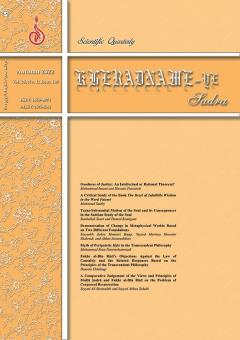-
-
List of Articles
-
Open Access Article
1 - Editor's Note
S. Mohammad Khamenei -
Open Access Article
2 - Goodness of Justice: An Intellectual or Rational Theorem?
Mohammad Imami حسین فرزانه -
Open Access Article
3 - A Critical Study of the Book, The Bezel of Infallible Wisdom in the Word Fatemi
Mahmoud Saidiy -
Open Access Article
4 - Trans-Substantial Motion of the Soul and its Consequences in the Sadrian Study of the Soul
Rouhollah Souri Hamed Komijani -
Open Access Article
5 - Demonstration of Change in Metaphysical Worlds Based on Two Different Foundations
Seyedeh Zahra Mousavi Baygi Seyyed Morteza Hosseini Shahrudi Abbas Javareshkiyan -
Open Access Article
6 - Myth of Peripatetic Hyle in the Transcendent Philosophy
Mohammad Reza Noornohammadi -
Open Access Article
7 - Against the Law of Causality and the Related Responses Based on the Principles of the Transcendent Philosophy
Hossein Oshshaqi -
Open Access Article
8 - A Comparative Judgement of the Views and Principles of Mullā Ṣadrā and Fakhr al-Dīn Rāzī on the Problem of Corporeal Resurrection
Seyyed Ali Razizadeh Seyyed Abbas Zahabi
-
The rights to this website are owned by the Raimag Press Management System.
Copyright © 2017-2026







